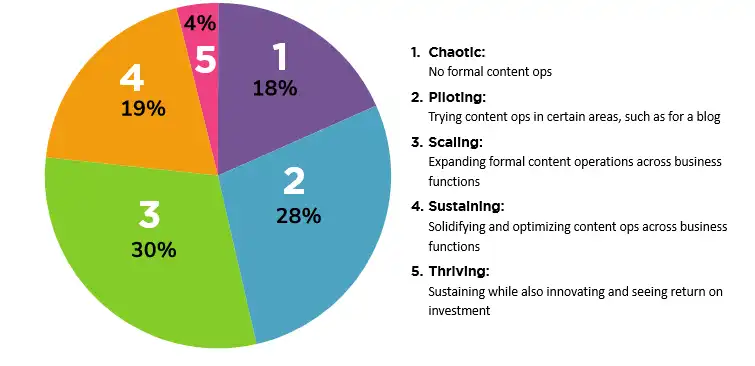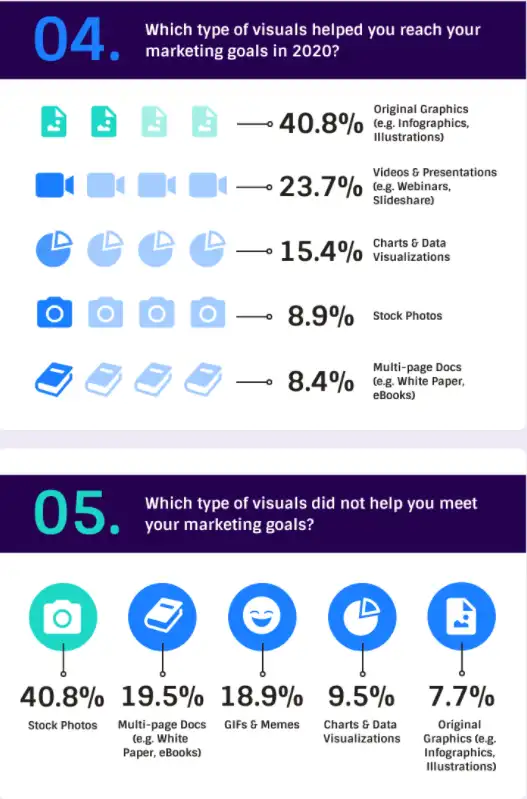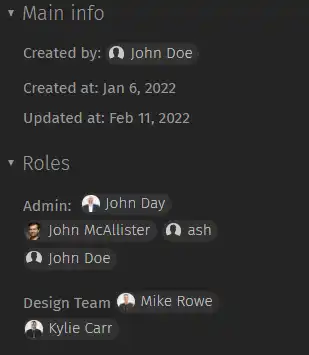Content Operations: What is it?
To understand Content Operations, let’s look at the rough steps that we all usually take in the creation of an article.
First, you need to brainstorm some ideas. Then, you’ll probably do keyword research for SEO optimization. Before publishing, you’ll proofread, edit, and prepare supplementary visuals. Finally, you’ll use a CMS system to publish the article on your blog.
At every step, you’ll use software tools, normalized processes, and methodologies that you’ve accustomed to. Altogether, these things are known as content operations - the tangly wiring behind the beautiful picture of content marketing. Thus, even if you didn’t know it by name, whatever steps your organization takes to create content can be labeled such.
Why Do We Need Content Operations?
Content operations are needed for the same reason that all other formalized methodologies and protocols exist - it eliminates ambiguity and provides a straightforward and understandable path to content creation.
Without a proper system in place, you’ll run into a number of problems that will clog your content pipeline by constant delays, setbacks, and a decrease in quality caused by a lack of a coherent vision in your content marketing team.
Properly set-up content operations not only improve the effectiveness of your marketing but also lead to bigger job satisfaction in your marketing team. When writers and editors agree on a vision and realize that they are working together to fulfill strategic needs, the process of writing becomes less like squabbles of creative visions and more like a collaborative effort.
Let’s look at the main issues that are caused by the lack of proper content ops and then talk about how you can improve such a situation today without too much of an investment.
Major Problems with Content Operations
The biggest issue with content operations is that many organizations simply don’t use it. There are many excuses and justifications for their absence but a lot of the time, it’s just a lack of awareness. Organizations don’t know that content operation is a thing that they need to use.
In a survey by Content Science, only 5% of companies defined their content ops as “thriving” while 18% described it as “chaotic.”

Lack of Coherent Vision in Writing Department
As any creative type, writers might hold tightly to their artistic freedoms and can be insistent on being left to their own devices to write freeform content that they’d like. Rather than arguing, editors go with the flow and try to hammer authors’ articles in a way that makes sense to them. As a consequence - constant disagreements, squabbles, and content that works neither as a creative piece nor as an element of content marketing strategy.
Per Upland Kapost's report, only 11% of content marketing teams create content based on organizational objectives. Others, create content that isn’t fully optimized and fails to reach target audiences.
Content Marketing Team Resources Being Spread Too Thin
A professional writer is a great boon that can be used not only for writing articles but also for proofreading landings, helping out the sales team with newsletters and email templates, and other writing assignments. Such multi-tasking becomes an issue when the best way to describe your workflow is “Primordial Chaos”. The writer starts working on one thing then they’re suddenly pulled sideways for an urgent assignment, then another one, and so on. By the end of it, they don’t remember anything, have to start working from scratch, and content delivery suffers as a consequence.
Content operations enable you to prioritize tasks, allowing authors to peacefully go from one task to another, knowing which they should handle first.
Disconnect Between Writers & Other Teams
Upland surveyed B2B marketers and found that almost half of marketing teams don’t know what other departments are doing. Content marketing should be good writing, first and foremost, but it cannot be self-serving. If marketers don’t understand the direction and purpose of their product (and these things are hard to gauge in isolation) then the content that they create is going to be ineffective at best.
Upland surveyed B2B marketers and found that almost half of marketing teams don’t know what other departments are doing. Content marketing should be good writing, first and foremost, but it cannot be self-serving. If marketers don’t understand the direction and purpose of their product (and these things are hard to gauge in isolation) then the content that they create is going to be ineffective at best.

"What they’ll think is that your brand doesn’t have its stuff together. Even worse, they’ll be confused and not sure which experience to consider as the true version. This means that all the hard work marketing has done across the organization will be minimized. That brand awareness you worked so hard for will be tarnished as prospects and customers find you less credible."
One of the critical purposes of the marketing department is to maintain brand consistency across all channels. Without content operations that facilitate constant communication with other teams, this goal is difficult to achieve.
Too Many Writers Not Enough Artists
According to Venngage, 40.8% of surveyed marketers agreed that original graphics helped them achieve their marketing goals in 2020. The same percentage said that stock photos were awfully inefficient at the same task.

It’s hard to imagine a modern content marketing post that doesn’t utilize powerful visuals, be it photos of your product, great infographics, charts, or other visual aids that were created in-house.
However, writing happens much faster than creating a premium illustration which means that a lot of your content is just collecting dust while it waits for its visual flair. A problem partially solved by re-purposing content but chaotic mess loves company.
If there is discord in the writing team, there is a high chance of a similar situation with the media library - mislabeled, outdated, and corrupted assets that are hard to make sense of.
Lack of Post-Release Support for Your Content
“Fire and forget” is a traditional approach to making content but that doesn’t get you anywhere. For starters, the majority of marketing teams only bother promoting their content once even though numbers indicate that some content types benefit more from 2nd and 3rd promos that can double or triple the number of impressions.
Then, there is a lack of research. Despite all the theories about what content should work, the best indicator is tangible performance - how many impressions, clicks, and leads did your last article generate in comparison to the previous ones? Does that mean that you should continue writing on a specific niche even if it seems “counterintuitive” to you? The thing is, without content operations you’ll never know. It’s always more fun to write new things than maintain and take care of things already written, so it’s not a surprise that writers - when left to their own devices - will focus on the former.
Poor Technological Stack
Almost a decade ago, I remember working for a company that didn’t even use Google Docs to collaborate on a document. Instead, the editor would write me long emails with things that they would prefer to be changed in my article and then I’ll send them a revised version and we’d do that all over again.
You can imagine how much time it took both of us to do things so inefficiently. Modern inefficiencies are more subtle, unfortunately, but they nonetheless slow you down. There are multiple productivity tools that most will be familiar with - Jira, Figma, Slack, etc. But there is one another of equal importance despite its lesser notoriety - Digital Asset Management (DAM)
How Digital Asset Management Can Help You With Content Operations
Digital asset management is a tool designed to make maintenance of the media library easy. Creating, sharing, and updating photos, videos, infographics, etc. is a task that can be cumbersome but it is essential for the establishment of the high-speed content pipeline.
Finding Visual Assets Fast & Hassle-free
Because content marketing writing is impossible to imagine without visual aids and because you don’t always have the resources to create visuals from scratch for every blog post, there is a high demand for an efficient way to recycle and repurpose existing content.
The question is: how would this process work out in your company? A lot of companies have, at best, a semi-centralized media library. This means that there is one place (in the cloud or on someone’s desktop) that stores all videos, images, etc. However, then the designer gets a memo that they need to update a few of them, they download it to their work machine and forget to re-upload it to the main repository.
And then these issues pile up to the point where everyone has this or that version of a single picture but nobody really knows which version is the decisive one and which one should be used in marketing materials.
So to use a single asset, a writer will have to hop from chat to chat asking where the picture is, can they use it, etc.
DAM solutions, such as Pics.io, solve this problem by providing you with a single source of truth for all digital assets. Making DAM an element of your content operations not only means that your assets will always be in one place but that to search for the right ones, your team won’t have to torture themselves for hours.
So instead of a mess described further, with DAM, finding a proper photo would look like this:
“Hey, I need a photo of a couch for my next article on best interior design tips”
“Sure, just look for couch assets with green marks that have a star rating of 5. These are good to go.

And the important part is that that conversation has to happen once preferably during onboarding. Once your writers understand the markets that they need to use to find approved assets in your media library, they can use a combination of keywords, custom fields, and marks to pinpoint the visuals that will help their next article.
Handling Watermarks & Licensed Assets
Although many have aversion to stock assets, they are still quite useful. If you handpick premium photos and alter them to fit the needs of your enterprise, they can be almost no different from original in-house assets in quality. The "almost" part comes from the need to purchase and maintain licenses for stock assets.
If you misuse the license you can get in trouble with the author, so Pics.io helps you to keep licenses and up-to-date assets in order.
For starters, there is a simple way to link licenses with their respective assets. You just need to select them both and then link them from the info panel.

So you can easily double-check if the asset's license is applicable for your planned use. Alternatively, you can use watermarking or restricted assets to notify your team which assets they can use.

Enable Efficient Cooperation Between Departments
DAM also has a built-in commenting section that speeds up communication between departments. All members of Pics.io are assigned a specific role. So if a new hire needs to get in touch with a designer, they don’t need to ask “who is x?” but just look at the roles section, and then @ required person on an asset that they need help with.


The notification system will then distribute that message to the designer across multiple channels: in Pics.io, via e-mail, and Slack. So they can see the problem, open the required asset directly in Photoshop (thanks to Pics.io’s Adobe Photoshop integration), and upload a new version of an asset as a new revision.
The notification system will then distribute that message to the designer across multiple channels: in Pics.io, via e-mail, and Slack. So they can see the problem, open the required asset directly in Photoshop (thanks to Pics.io’s Adobe Photoshop integration), and upload a new version of an asset as a new revision.

These revisions can be then viewed side-by-side to ensure that it is exactly what the writer asked for. In any case, you can always just revert to a previous version with one click.

Sharing & Receiving Assets Outside Your Organization
One way to solve issues with slow visual content delivery is hiring freelancers or third-party agencies that can generate original assets for your blog.
Sharing stuff isn’t without problems, either. Two common problems we keep hearing about are:
“People share assets with us through free services that cannot handle large, high-quality files or are too slow. Then, there is an issue that we must maintain communication and assets in separate applications that makes the process inefficient”
“We’d like to use our existing environment to share assets with third parties but we don’t want to compromise our security. What if guests will accidentally see assets that they shouldn’t have?”
Pics.io solves these issues in one clean swoop thanks to Inboxes. Inboxes work like isolated instances of Pics.io - everyone with a link to a specific inbox can use it to share assets with you but they don’t get access to the full environment. From there, you can simply link the asset to the collection inside Pics.io that you’d like.
On the flip side, if you need to share assets with others, that’s the job for Websites functionality that lets you upload the entire collection as branded online pages. This is especially useful if you want to discuss assets with third parties as you can set up sharing to let third-parties view comments and revision history on all shared assets.
Conclusion
Content operations are the backend to content marketing's front end. Yeah, it’s not that pretty, and always messy (even when all optimizations are in place) and it’s not really “fun” to follow a structure when you deem yourself a creative type, but it’s oh so necessary.
Digital Asset Management helps you solve one crucial pain pertaining to inefficient content ops and that is the delivery of branded assets to the people that need them. No matter how efficient the other parts of your content ops are going to be, you absolutely won’t publish a new blog post if it doesn’t have visual flair. It is awkward to have a great piece of writing on your hands just sitting there because you can’t provide the writing team with the photos, infographics, and videos that they need.
So, come one step closer to solving your content ops issues by trying Pics.io out today, for free. Take a 7-day trial or book a demo with us and see for yourself how much it can help. See you there!
Curious? Learn more about Pics.io or book a demo with us and we'll answer all of your questions!



